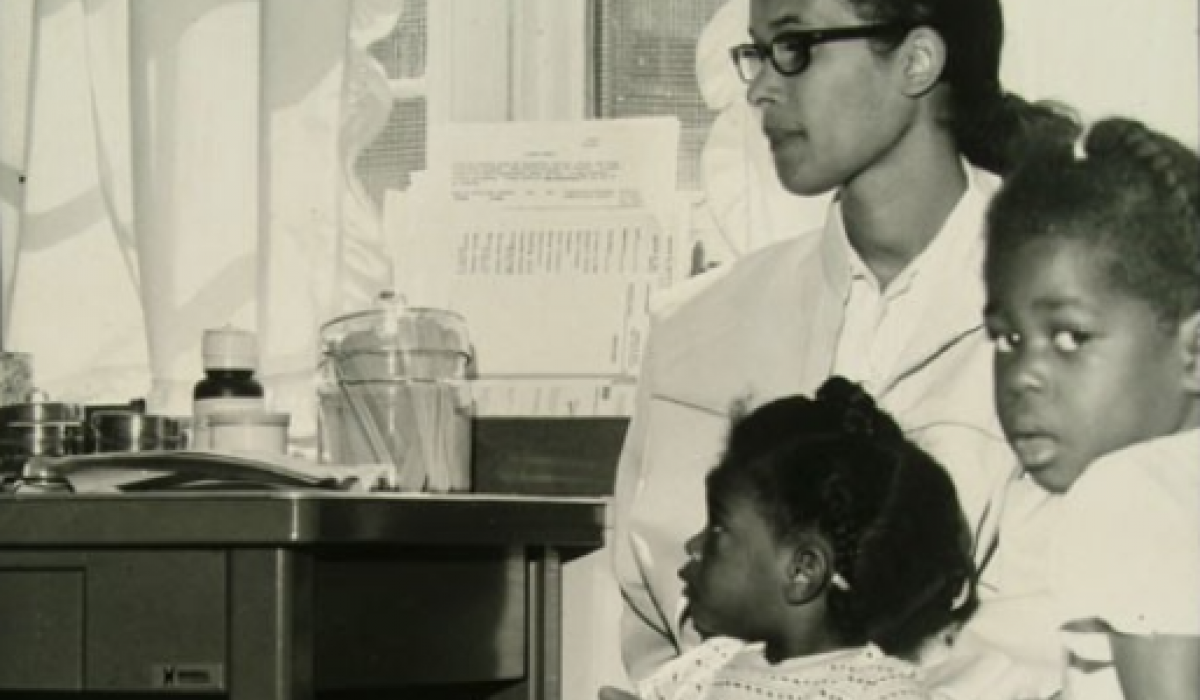In the United States, Black Americans have a shorter life expectancy than white Americans by more than 3.5 years. They're more likely to die from cardiovascular disease than white Americans, and almost twice as likely to suffer a stroke. They have the highest cancer mortality rate of any race or ethnicity. But these inequalities are not biologically determined; they're the results of structural anti-Black racism in the systems that contribute to health outcomes and the systems that treat them.
Maybe money can’t buy happiness, but it can often buy health. It can buy safe housing in a neighborhood with clean air and water, recreation space, and good schools. It can buy easy access to grocery stores with healthy food options and it can buy the healthy foods themselves.

Over the last century, Black people in this country have been denied access to financial services like home loans and been banned from purchasing homes in majority white neighborhoods. Today, they have 30 percent lower rates of homeownership than white Americans and they’re more likely to live in neighborhoods with lower property values, worse infrastructure, and fewer amenities. They’ve been cut off from many opportunities to acquire wealth, and the good health money can buy.
On top of this, Black Americans are more likely to live in toxic industrial areas or in homes with toxic lead paint, putting them at a higher risk to develop asthma and certain cancers. They’re subject to higher rates of stress — influenced by factors like aggressive neighborhood policing, food insecurity, and high rates of unemployment — which can lead to chronic health issues like diabetes and hypertension.

Healthcare in the United States has racial disparities, as well. Black Americans have historically been mistreated by medical professionals, including through exploitation in 20th-century medical research trials, and they have less trust in the healthcare system than other races. This lack of trust is understandable: even today, unconscious bias in medicine leads to Black Americans receiving inferior care and treatment. Most notably, Black women experience the highest infant mortality rates among all racial groups in the United States regardless of socioeconomic status.
Quite literally, the lives of Black Americans depend on eliminating racism.
Sources for the information above are cited at the bottom of this page.
Explore a curated sample of Harvard research and resources related to anti-Black racism in public health below.
Read
The Racial Ecology of Lead Poisoning: Toxic Inequality in Chicago Neighborhoods, 1995-2013
Racial disparities in lead poisoning existed years before the Flint, Michigan Water Crisis made headlines in 2014. This study demonstrates a direct link between racial segregation, environmental hazards, and poor health outcomes.
Analyze
Watch
Epidemics and African American Communities from 1793 to the Present
Webinar series hosted by Professor Evelynn Hammonds of Harvard's Hutchins Center for African and African American Research on the impact historic structural inequality and anti-Black racism have on the COVID-19 pandemic and its disproportionate impact on Black American communities.
Medical Racism from 1619 to the Present: History Matters || Harvard Radcliffe Institute
Speakers on this panel examine the roots in slavery of contemporary African American mistrust of the healthcare system, the lack of trust in medical providers fostered by experiences of everyday racism, and the African American community’s long dependence, born of necessity, on care from within the community.
Citations for Section Overview
- Arias, Elizabeth. "Changes in Life Expectancy by Race and Hispanic Origin in the United States, 2013–2014." NCHS data brief, no 244. Hyattsville, MD: National Center for Health Statistics. 2016. https://www.cdc.gov/nchs/products/databriefs/db244.htm.
- Coates, Ta-Nehisi. 2014. “The Racist Housing Policies That Built Ferguson.” The Atlantic. October 17, 2014.https://www.theatlantic.com/business/archive/2014/10/the-racist-housing-policies-that-built-ferguson/381595/.
- Cooksey-Stowers, Kristen, Marlene B. Schwartz, and Kelly D. Brownell. 2017. “Food Swamps Predict Obesity Rates Better Than Food Deserts in the United States.” International Journal of Environmental Research and Public Health 14 (11). https://doi.org/10.3390/ijerph14111366.
- Demby, Gene. 2018. “Making The Case That Discrimination Is Bad For Your Health.” NPR.Org. January 14, 2018.https://www.npr.org/sections/codeswitch/2018/01/14/577664626/making-the-case-that-discrimination-is-bad-for-your-health.
- Heart Disease and Stroke Statistics – 2009 Update: A Report from the American Heart Association Statistics Committee and Stroke Statistics Subcommittee. Circulation. 2008. https://doi.org/10.1161/CIRCULATIONAHA.108.191261
- Lavizzo-Mourey, Risa, and David Williams. 2016. “Being Black Is Bad for Your Health.” US News & World Report. April 14, 2016. https://www.usnews.com/opinion/blogs/policy-dose/articles/2016-04-14/theres-a-huge-health-equity-gap-between-whites-and-minorities.
- Leonhardt, David. 2015. “Middle-Class Black Families, in Low-Income Neighborhoods.” The New York Times, June 24, 2015, sec. The Upshot. https://www.nytimes.com/2015/06/25/upshot/middle-class-black-families-in-low-income-neighborhoods.html.
- Sewell, Alyasah, Kevin Jefferson, and Hedwig Lee. 2016. “Living Under Surveillance: Gender, Psychological Distress, and Stop-Question-and-Frisk Policing in New York City.” Social Science & Medicine 159 (April). https://doi.org/10.1016/j.socscimed.2016.04.024.
- Shukla, Shipra. 2007. “Scholar Speaks About History of Medical Experimentation on African Americans.” UCSF News Center. December 17, 2007. https://www.ucsf.edu/news/2007/12/7682/scholar-speaks-about-history-medical-experimentation-african-american.
- Smith, Imari Z., Keisha L. Bentley-Edwards, Salimah El-Amin, and William Darity, Jr. 2018. “Fighting at Birth: Eradicating the Black-White Infant Mortality Gap.” Duke University’s Samuel DuBois Cook Center on Social Equity and Insight Center for Community Economic Development. https://socialequity.duke.edu/wp-content/uploads/2019/12/Eradicating-Black-Infant-Mortality-March-2018.pdf.
- Thulin, Lila. 2020. “What ‘Racism Is a Public Health Issue’ Means.” Smithsonian Magazine. July 20, 2020.https://www.smithsonianmag.com/science-nature/what-racism-public-health-issue-means-180975326/.
- U.S. Cancer Statistics Working Group. U.S. Cancer Statistics Data Visualizations Tool, based on 2019 submission data (1999-2017): U.S. Department of Health and Human Services, Centers for Disease Control and Prevention and National Cancer Institute; www.cdc.gov/cancer/dataviz, released in June 2020.
- U.S. Census Bureau, Current Population Survey/Housing Vacancy Survey, February 2, 2021. https://www.census.gov/housing/hvs/files/currenthvspress.pdf.
- Washington, Jesse. 2020. “New Poll Shows Black Americans Put Far Less Trust in Doctors and Hospitals Than White People.” The Undefeated. October 14, 2020. https://theundefeated.com/features/new-poll-shows-black-americans-put-far-less-trust-in-doctors-and-hospitals-than-white-people/.
- Williams, David R., Jourdyn A. Lawrence, and Brigette A. Davis. 2019. “Racism and Health: Evidence and Needed Research.” Annual Review of Public Health 40 (1): 105–25. https://doi.org/10.1146/annurev-publhealth-040218-043750.
Citations for Page Images
- Black mother and two young children at a health center in Boston, 1968 | Two informal portraits of mothers with their young children. They are patrons of the Martha M. Eliot Family Health Center. Part of Martha May Eliot Papers. Folder: Other State and Local Activities: Children's Mission to Children, Boston: Oversize volume of photographs of Eliot Center, with dedication to MME, 1968. RLG collection level record MHVW85-A160. http://id.lib.harvard.edu/images/olvgroup1003600/catalog
- Impoverished D.C. neighborhood with mostly Black residents, 1930s | Beals, Jessie Tarbox. Circa 1935-1939. View of tenement housing and yards from above. Buildings have corrugated metal fencing; yards are strewn with garbage, including washboards, cookware, screen doors, firewood, and crates. Part of Jessie Tarbox Beals Photographs. Folder: Professional Life: Hotel Allerton, Chicago, Ill.: interiors, ca. 1933: Washington, D.C.: poor people's housing (exteriors), probably late 1930s [6-5]. RLG collection level record MHVW88-A481. Schlesinger Library on the History of Women in America, Radcliffe Institute PC60-89-11. http://id.lib.harvard.edu/images/olvgroup1004243/urn-3:RAD.SCHL:279582/catalog
- A white doctor talks with her Black patient at a Boston health center, 1968 | Carsten, Teresa E. R. Untitled, 1968. Part of Martha May Eliot Papers. Folder: Other State and Local Activities: Children's Mission to Children, Boston: Oversize volume of photographs of Eliot Center, with dedication to MME, 1968. RLG collection level record MHVW85-A160. Schlesinger Library on the History of Women in America, Radcliffe Institute MC229-9vo-21. http://id.lib.harvard.edu/images/olvgroup1003601/urn-3:RAD.SCHL:138339/catalog
